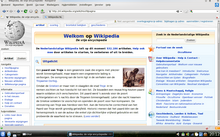KHTML is a discontinued[3] browser engine that was developed by the KDE project. It originated as the engine of the Konqueror browser in the late 1990s, but active development ceased in 2016.[1][4] It was officially discontinued in 2023.[3]
 | |
| Developer(s) | KDE |
|---|---|
| Stable release | 5.111.0 (September 10, 2023) [±][1] |
| Repository | invent |
| Written in | C++[2] |
| Type | Browser engine |
| License | GNU Lesser General Public License |
Built on the KParts framework and written in C++, KHTML had relatively good support for Web standards during its prime. Engines forked from KHTML are used by most of the browsers that are widely used today, including WebKit (Safari) and Blink (Google Chrome, Chromium, Microsoft Edge, Opera, Vivaldi and Brave).
History edit
Origins edit
KHTML was preceded by an earlier engine called khtmlw or the KDE HTML Widget, developed by Torben Weis and Martin Jones,[5][6] which implemented support for HTML 3.2, HTTP 1.0, and HTML frames, but not the W3C DOM, CSS, or JavaScript.
KHTML itself came into existence on November 4, 1998,[5] as a fork of the khtmlw library, with some slight refactoring and the addition of Unicode support and changes to support the move to Qt 2. Waldo Bastian[7] was among those who did the work of creating that early version of KHTML.[5]
Re-write and improvement edit
The real work on KHTML actually started between May and October 1999, with the realization that the choice facing the project was "either do a significant effort to move KHTML forward or to use Mozilla"[5] and with adding support for JavaScript as the highest priority. So in May 1999, Lars Knoll[8] began doing research with an eye toward implementing the W3C DOM specification, finally announcing[9] on August 16, 1999 that he had checked in[10] what amounted to a complete rewrite of the KHTML library—changing KHTML to use the standard W3C DOM as its internal document representation. That in turn allowed the beginnings of JavaScript support to be added in October 1999,[5] with the integration of Harri Porten's KJS following shortly afterwards.
In the closing months of 1999 and first few months of 2000, Knoll did further work with Antti Koivisto and Dirk Mueller[5][11][12] to add CSS support and to refine and stabilize the KHTML architecture,[5] with most of that work being completed by March 2000. Among other things, those changes enabled KHTML to become the second browser after Internet Explorer to correctly support Hebrew and Arabic and languages written right-to-left[5]—before Mozilla had such support.
KDE 2.0 was the first KDE release (on October 23, 2000) to include KHTML[13] (as the rendering engine of the new Konqueror file and web browser, which replaced the monolithic KDE File Manager).
Other modules edit
KSVG was first developed in 2001 by Nikolas Zimmermann and Rob Buis; however, by 2003, it was decided to fork the then-current KSVG implementation into two new projects: KDOM/KSVG2 (to improve the state of DOM rendering in KHTML underneath a more formidable SVG 1.0 render state) and Kcanvas (to abstract any rendering done within khtml/ksvg2 in a single shared library, with multiple backends for it, e.g., Cairo/Qt, etc.).[14]
KSVG2 is also a part of WebKit.[15]
Sunsetting edit
KHTML was scheduled to be removed in KDE Frameworks 6.[4] Active development ended in 2016, just the necessary maintenance to work with updates to Frameworks 5.[1] It was officially discontinued in 2023.[3]
Standards compliance edit
The following standards are supported by the KHTML engine:
Descendants edit
KHTML and KJS were adopted by Apple in 2002 for use in the Safari web browser. Apple publishes the source code for their fork of the KHTML engine, called WebKit. In 2013, Google began development on a fork of WebKit, called Blink.[17]
See also edit
References edit
- ^ a b c "KHTML commit log". KDE Invent. Retrieved 2021-09-14.
- ^ "KHTML repository analytics". invent.kde.org. Retrieved 2020-08-15.
- ^ a b c "KHTML repository". GitHub. Retrieved 5 May 2023.
Removed for KF6, the 'kf5' branch contains the last maintained state.
- ^ a b "Port Konqueror away from KHTML". phabricator.kde.org. Retrieved 2023-05-05.
- ^ a b c d e f g h "Lars Knoll and George Staikos: From KDE to WebKit". YouTube. Retrieved 1 September 2019.
- ^ "KDE/kde1-kdelibs/khtmlw". GitHub. Retrieved 2020-01-23.
- ^ "Waldo Bastian | Behind KDE". Behindkde.org. Retrieved 1 September 2019.
- ^ "Lars Knoll | Behind KDE". Behindkde.org. Retrieved 1 September 2019.
- ^ "'changes in KHTML' - MARC". Marc.info. Retrieved 1 September 2019.
- ^ "'khtml_to_dom: kdelibs/khtml' - MARC". Marc.info. Retrieved 1 September 2019.
- ^ "WebKit Team – WebKit". Trac.webkit.org. Retrieved 1 September 2019.
- ^ "Dirk Mueller | Behind KDE". Behindkde.org. Retrieved 1 September 2019.
- ^ "Lars Knoll and George Staikos: From KDE to WebKit". YouTube. Retrieved 1 September 2019.
- ^ [1][permanent dead link]
- ^ "The WebKit Open Source Project". Webkit.org. 7 November 2015. Retrieved 1 September 2019.
- ^ "KDE 3.5.6 Changelog". K Desktop Environment.
- ^ "Blink: A rendering engine for the Chromium project". Blog.chromium.org. Retrieved 1 September 2019.
External links edit
- Web Browser – the Konqueror website
- KHTML – KDE's HTML library – description at developer.kde.org
- KHTML at the KDE API Reference
- KHTML at the KDE git repository
- KHTML bugs fixed in the last year (self-updating query)
- From KDE to WebKit: The Open Source Engine That's Here to Stay – presentation at Yahoo! office by Lars Knoll and George Staikos on December 8, 2006 (video)